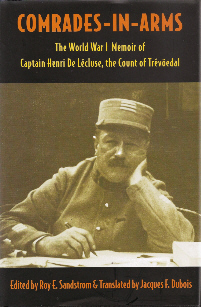Comrades-In-Arms,
The World War I Memoir of Captain Henri De Lécluse,
the Count of Trévöedal
Edited by Roy E. Sandstrom & translated by Jacques F. Dubois
Published by: The Kent University Press, 1998
One would never expect to find a handwritten manuscript by an aristocratic French World War I officer in an estate sale in Grinnell, Iowa! Two manuscripts by Captain Lécluse were found in this treasure trove: one a hastily scribbled combat diary and the second a carefully written memoir based upon the diary. The stories in both of these writings take place at the front from 6 December 1914 through 22 August 1916.
Captain Lécluse attended the French military academy of Saint-Cyr, received his cavalry training at Saumur, was commissioned on 1 January 1893, served in the reserves, and was promoted to captain in the territorial army on 14 July 1914. The count served in the Fourth Squadron, Ninth Light Group and the Tenth Squadron, Second Light Group. His memoir is not a history of these units but a personal effort to describe his experience and to memorialize his men who fought and died for France. From occupying captured German trenches, accurately "zeroed in" by the enemy, and the resulting carnage, to humorous accounts of antics by the men in his unit, to deeply felt religious experiences, to memorials of the fallen, the 33 chapters each share a vignette of the horror, misery, conditions, humor, and camaraderie of the front.
The editor correctly describes the memoir as passionate, often patriotic, and far from objective. No wonder—the author is a turn-of-the-century aristocrat, imbued with the traditions of his class and caste, influenced by the philosophies of the 19th century and the mores of the prewar period. His description of the colonial African troops, for example, while admiring of their fighting abilities, is somewhat condescending when describing them as simple and childlike—obviously not as civilized as the French. He is deeply religious, a devout Catholic, and it shows in his descriptions of destroyed churches, moving memorials to the dead, and participation in worship services at the front.
Captain Lécluse eventually immigrated to the United States, his son dead in the war, his business ruined by a hireling while he fought for his country, and his estates sold to pay debts. He, his wife, and daughter settled in St. Louise, Missouri, where he was a professor of French language and literature at Lindenwood College. In 1945, he moved to Grinnell, Iowa, where he died later that year—hence the surprising location of the manuscripts. Whereas the introduction, editorial content, and conclusion are clearly written by an academician (the editor is, after all, an associate professor of history at the University of Northern Iowa), the 33 memoir chapters are faithfully translated and explained where required.
This book, devoid of strategy, tactics, maps and the thought processes of generals, turned out to be for me a thoughtful, very personal memoir of a dutiful, patriotic soldier.
Bruce Sloan
 |
The editor correctly describes the memoir as passionate, often patriotic, and far from objective. No wonder—the author is a turn-of-the-century aristocrat, imbued with the traditions of his class and caste, influenced by the philosophies of the 19th century and the mores of the prewar period. His description of the colonial African troops, for example, while admiring of their fighting abilities, is somewhat condescending when describing them as simple and childlike—obviously not as civilized as the French. He is deeply religious, a devout Catholic, and it shows in his descriptions of destroyed churches, moving memorials to the dead, and participation in worship services at the front.
Captain Lécluse eventually immigrated to the United States, his son dead in the war, his business ruined by a hireling while he fought for his country, and his estates sold to pay debts. He, his wife, and daughter settled in St. Louise, Missouri, where he was a professor of French language and literature at Lindenwood College. In 1945, he moved to Grinnell, Iowa, where he died later that year—hence the surprising location of the manuscripts. Whereas the introduction, editorial content, and conclusion are clearly written by an academician (the editor is, after all, an associate professor of history at the University of Northern Iowa), the 33 memoir chapters are faithfully translated and explained where required.
This book, devoid of strategy, tactics, maps and the thought processes of generals, turned out to be for me a thoughtful, very personal memoir of a dutiful, patriotic soldier.

No comments:
Post a Comment